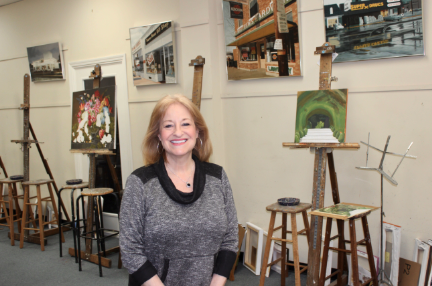Mary Louise Schrodt’s Paintings Capture the Essence of St. Matthews in the 1980s
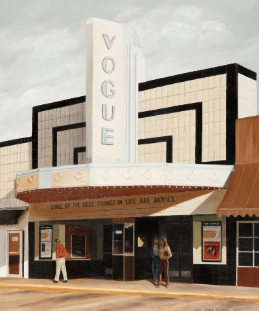 Mary Louise Schrodt was walking to her St. Matthews art studio one rainy morning in the early 1980s when she was struck by the reflections of the storefronts in puddles on the pavement. The city had become her home, and she was inspired to create a series of 32 oil paintings featuring its various storefronts.
Mary Louise Schrodt was walking to her St. Matthews art studio one rainy morning in the early 1980s when she was struck by the reflections of the storefronts in puddles on the pavement. The city had become her home, and she was inspired to create a series of 32 oil paintings featuring its various storefronts.
“She really loved St. Matthews, it was near and dear to her heart,” says Judy Warren, the late artist’s daughter. “St. Matthews was mom’s stomping ground, and she very rarely left the area.”
Schrodt began the project by photographing dozens of storefronts around St. Matthews, then turning those photos into oil paintings. All of the photographs were taken in the early 1980s, but some of the paintings were not completed until the mid-1990s.
The series is now for sale, and Schrodt’s children are searching for a buyer who is interested in all 32 pieces.
“Before my mother died, she said with no uncertainty, ‘Do not split up the series,’” Warren says. “When the paintings are displayed together, people go gaga for them.”
For security and protection purposes, the series has been in storage for quite some time. There have been various public showings, including most recently at Actors Theatre in downtown Louisville, but Warren is hopeful the series can find a permanent home to be displayed.
The series features a rare glimpse into the past, serving as a tribute to Schrodt’s beloved St. Matthews. The paintings feature a combination of businesses that are still standing, as well as some that no longer exist.
The first painting in the series (Lexington Rd. at Macon, 1981), depicts Top Hat Liquors, the establishment next to the original Schrodt Art Studio. That studio opened in 1975 after Schrodt, who was working as the dean of the arts department at Sacred Heart Academy, married Warren’s stepfather Paul Schrodt.
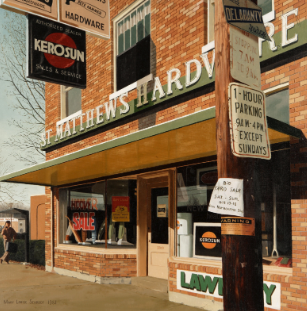 “Paul suggested building an art studio for my mom in the home,” Warren says. “Mom said, ‘If you really want me to paint, you won’t put a studio in my home,’” noting all the distractions of daily life that would get in her way.
“Paul suggested building an art studio for my mom in the home,” Warren says. “Mom said, ‘If you really want me to paint, you won’t put a studio in my home,’” noting all the distractions of daily life that would get in her way.
Another painting captures popular watering hole Gerstle’s Bar (Cold Beer: No Coils, 1983) which looks nearly identical decades later. A family friend was unexpectedly captured in the photos Schrodt took of Gerstle’s and can be seen leaving the establishment in the painting.
Fast-food joint White Castle is the only building featured in two separate paintings, first on an 18×28 canvas (Night Shift, 1982), and years later in a larger 28×40 painting (Dawn Patrol, 1987).
The recently demolished St. Matthews Hardware, which was in business for nearly a century, is the subject of one of the paintings (Hoover Sale, 1983). In a personal touch, Schrodt included the family’s home address from the Norbourne Estates neighborhood on a flier in front of the building advertising a yard sale.
“For anyone interested in the history of St. Matthews, the series makes such a strong statement when hung together,” Warren says. “I grew up in St. Matthews, so to me, they become more nostalgic every year.”
Schrodt took a special interest in the project because she wanted to preserve the history of the city she loved so much. As retailers began to change and buildings were leveled to make way for new development, she sought to forever capture the essence of St. Matthews in the 1980s.
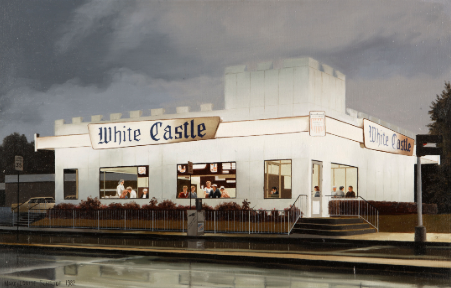 Schrodt Art Studio is one of the businesses that has experienced a change in scenery. In the first few years, Schrodt offered small classes to make just enough money to cover the studio’s rent each month. By the time of Schrodt’s death in 2001, there was a waiting list of nearly two years for new students to register for classes.
Schrodt Art Studio is one of the businesses that has experienced a change in scenery. In the first few years, Schrodt offered small classes to make just enough money to cover the studio’s rent each month. By the time of Schrodt’s death in 2001, there was a waiting list of nearly two years for new students to register for classes.
Schrodt laid the building blocks for a close-knit community of budding artists in Louisville, which Warren has continued since joining the studio in 1993.
“There was no advertising, it was all word of mouth,” Warren says. “People would call up and say they wanted to come paint. Once people got in, they didn’t leave.”
The studio moved to a new location off Dutchmans Lane (in the same building as Village 8 Theatres) in 2005, offering classes Tuesday through Saturday. Warren was at first hesitant to move into the space, but some prodding from Assistant Director Susan Cutchins, who came on board with the studio in 1991, convinced her of a greater vision. The space was on the first floor and offered plenty of parking (two things the original location was missing), and the duo transformed it into the perfect studio.
Despite the change in location, the studio still carries on its original mission, established by Schrodt more than 40 years ago: instructing and encouraging fledgling painters at all skill levels. Today’s classes are comprised of students across all levels of ability, with most having little or no painting experience when they start.
 Warren follows her mother’s method of teaching where students base their oil paintings off photographs, just as Schrodt did with the St. Matthews series.
Warren follows her mother’s method of teaching where students base their oil paintings off photographs, just as Schrodt did with the St. Matthews series.
“I have a very step-by-step, practical method of teaching, we’re not just throwing people up at the easel,” Warren says.
She often sees apprehension from first-time students, whose artistic ability may have long ago been quashed. Warren helps build up their confidence by walking them through the process, ensuring students can work toward their desired result. A binder full of photos serves as a starting point for students, who first get experience painting simpler pieces like flowers or fruit, to get their feet wet.
“My job is to pace them and not let them bite off more than they can chew,” says Warren, noting she does not want students to become frustrated and quit before they ever really give the class a chance. “It’s such a joy to watch someone who never thought they could paint make their first canvas and be so excited.”
Schrodt Art Studio is known for training students to see color correctly, a skill that is crucial to painting. After learning the basics, students are free to express their creativity however they like. Looking around the studio following a recent Saturday morning class, the works in progress on the easels ranged from beginners crafting their first pears and tulips, to more advanced students who have won awards for their pieces.
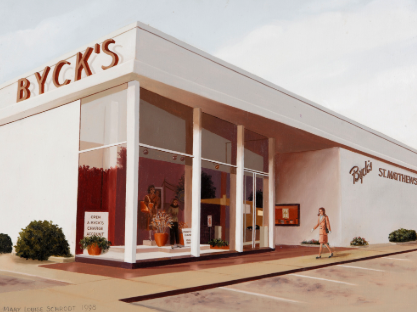 Schrodt’s legacy lives on in the classes taught by Warren and Cutchins, as well as in her pieces that are displayed throughout the studio. Aside from the St. Matthews series, Schrodt was well-known for her trompe l’oeil works, which is French for “fool the eye.” The art is designed to mesh so well with their environment, that one does not realize they are paintings.
Schrodt’s legacy lives on in the classes taught by Warren and Cutchins, as well as in her pieces that are displayed throughout the studio. Aside from the St. Matthews series, Schrodt was well-known for her trompe l’oeil works, which is French for “fool the eye.” The art is designed to mesh so well with their environment, that one does not realize they are paintings.
One of the first things a person sees upon entering the studio is a soda vending machine or is it? What appears to be a vending machine is actually a perfectly painted replication, down to the money slot. Just as with her St. Matthews series, Schrodt included some personal touches in these works as well. The Diet Coke vending machine has a reflection of Schrodt taking the photograph painted on and includes her name on one of the button options.
Schrodt’s humor also comes through, as step 3 on the directions for how to operate the machine reads, “If light appears in push button – that’s amazing…call CNN!”
“Mom had a great sense of humor, and that’s one of the things that’s great about this studio,” Warren says. “I have the greatest job in the world. I teach, I laugh, and sometimes I get to work on my own paintings.”
For more information on taking classes at the studio, call 502-893-2842.


